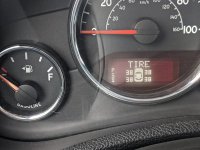Tanktitan
Member
People often ask what air pressure they should run after they replace stock tires with oversized tires. Many assume that they always have to run the pressure listed on the door panel. I even heard one say that you should run what is on the tire sidewall. Most on this forum know that if you do either of these, you are going to jar the fillings out of your teeth.
I recently spoke with some Michelin/BF Goodrich (BFG is owned by Michelin) technical people and posed this question. The answer is that each tire is designed to support various weights at various PSI’s; vehicles are designed to support its own weight, plus other factors like G forces, potholes, hills and the like. Once the OEM tires are selected, the tire pressure on the door is set for the combination of that tire and the specific forces that vehicle is rated to experience.
Naturally, if you change tire sizes, the proper tire pressure changes for your vehicle. My 2016 JK came with BFG KM2 LT 255/75R 17 tires. FCA required BFG to support 2055 pounds per tire position. BFG called for 37psi to do so and Jeep put that on the door.
According to BFG, my 37” KM2’s should be run at 25psi to achieve a load rating of 2150 pounds. A friend contacted BFG about his 2014 JK, now running 35” KO2’s. They instructed him to run 30 psi.
To quote BFG’s email back to me: “If your vehicle has a different size tire than what was specified by your vehicle manufacturer, it is important that the tires be inflated to provide the same load capability of the original tire size at the manufacturer’s recommended pressure.
Based on the information provided your OE tire size LT 255/75 r17, PSI is 37 and the load is up to 2055 lbs. The new tire size 37x12.50x17, PSI is 25 and the load is up to 2150 lbs.
… if we can assist you further, please respond to this email or call us at 866-866-6605 (toll-free) between 8:00 a.m. and 8:00 p.m. EST Monday through Saturday.
We appreciate your business and thank you for choosing Michelin.”
Sent from my iPhone using WAYALIFE mobile app
I recently spoke with some Michelin/BF Goodrich (BFG is owned by Michelin) technical people and posed this question. The answer is that each tire is designed to support various weights at various PSI’s; vehicles are designed to support its own weight, plus other factors like G forces, potholes, hills and the like. Once the OEM tires are selected, the tire pressure on the door is set for the combination of that tire and the specific forces that vehicle is rated to experience.
Naturally, if you change tire sizes, the proper tire pressure changes for your vehicle. My 2016 JK came with BFG KM2 LT 255/75R 17 tires. FCA required BFG to support 2055 pounds per tire position. BFG called for 37psi to do so and Jeep put that on the door.
According to BFG, my 37” KM2’s should be run at 25psi to achieve a load rating of 2150 pounds. A friend contacted BFG about his 2014 JK, now running 35” KO2’s. They instructed him to run 30 psi.
To quote BFG’s email back to me: “If your vehicle has a different size tire than what was specified by your vehicle manufacturer, it is important that the tires be inflated to provide the same load capability of the original tire size at the manufacturer’s recommended pressure.
Based on the information provided your OE tire size LT 255/75 r17, PSI is 37 and the load is up to 2055 lbs. The new tire size 37x12.50x17, PSI is 25 and the load is up to 2150 lbs.
… if we can assist you further, please respond to this email or call us at 866-866-6605 (toll-free) between 8:00 a.m. and 8:00 p.m. EST Monday through Saturday.
We appreciate your business and thank you for choosing Michelin.”
Sent from my iPhone using WAYALIFE mobile app


